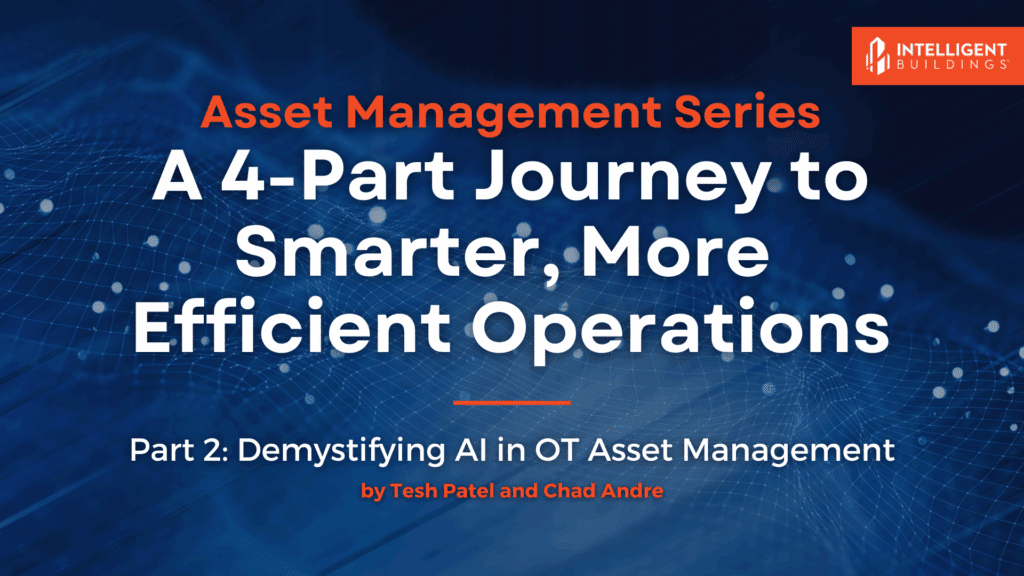
by Tesh Patel and Chad Andre
Our Asset Management Series
Did you miss Part 1? Check them out here:
IB Website: Maximizing Efficiency in OT Asset Management
LinkedIn: Maximizing Efficiency in OT Asset Management
PART 2 – Demystifying AI in OT Asset Management
Artificial intelligence (AI) has become the buzzword of the decade, but for commercial real estate (CRE) asset and portfolio managers, the hype often obscures the real opportunity. In operational technology (OT) asset management, AI isn’t about replacing people or chasing flashy software. It’s about making smarter, faster decisions using the data already generated by your building systems.
This post builds on Part 1’s focus on efficiency by breaking down how AI can enhance asset visibility, reduce downtime, and improve decision-making—without adding complexity or unproven technologies to your environment.
Why AI Matters for OT Asset Management
Most buildings today have intelligent systems that produce vast amounts of data: runtime logs, energy consumption patterns, sensor readings, maintenance histories, and more. However, the challenge lies in turning that data into actionable insights. That’s where AI comes in. When used responsibly, AI can:
- Identify anomalies in equipment behavior before they become failures
- Optimize maintenance schedules and reduce emergency repair costs
- Classify and digitize asset inventories during property onboarding
- Streamline work order triage and resource allocation
Let’s explore how these use cases apply in the built environment.
1. Anomaly Detection: Catching Issues Early – AI-enabled fault detection and diagnostics (FDD) systems can monitor OT assets like HVAC units, pumps, or lighting systems in real time. When patterns deviate from expected behavior—such as a motor drawing too much current or an air handler cycling irregularly—AI can trigger alerts before a system fails.
For asset managers, this means fewer tenant complaints, reduced emergency repair costs, and longer equipment life. Also, AI empowers teams to act early and avoid disruption rather than relying solely on manual inspections or reactive service calls.
2. Predictive Maintenance: Planning Ahead, Not Catching Up – AI can analyze equipment usage data, weather conditions, and historical failure trends to forecast when a component is likely to fail. These insights support smarter capital planning, more efficient technician scheduling, and reduced overtime costs.
Asset managers don’t need to invest in proprietary platforms or complex integrations to get started. Many service providers now embed AI-driven insights into their maintenance models, allowing teams to make data-informed decisions using existing workflows.
3. Smart Onboarding: Faster Asset Inventory & Classification – AI is increasingly used to accelerate the onboarding of new buildings. Natural language processing (NLP) and machine learning can extract and classify equipment data from PDFs, drawings, and legacy documents to help create a standardized digital asset inventory.
Instead of relying on engineers to manually tag and input data, a process that can take weeks, AI-assisted onboarding reduces labor requirements and speeds time to value. For portfolio managers, adding new acquisitions means faster visibility and integration into centralized systems.
4. Work Order Optimization: Doing More with Less – AI can also support smarter dispatching and triage. AI can help prioritize incoming tickets, reduce duplicate requests, and improve technician routing by analyzing historical work orders, asset criticality, and task duration.
For teams facing labor shortages or rising service costs, this kind of automation can preserve service levels without increasing headcount.
Avoiding the AI Trap
What Not to Do
Not all AI is created equal. Many PropTech solutions promise sweeping AI benefits but have long implementation cycles, lack of integration with OT systems, or limited return on investment (ROI). Asset managers should focus on vendors who:
- Offer AI features as part of proven service models
- Integrate with existing building systems and data sources
- Demonstrate measurable impact on uptime, cost reduction, or labor efficiency
Avoid solutions that require replacing your current tech stack or adding unnecessary software layers.
Practical Steps for Asset Managers
AI adoption doesn’t require a major overhaul. Start small and scale smart:
- Pilot AI-driven fault detection on one critical system (e.g., HVAC)
- Use AI to assist in asset inventory digitization during property onboarding
- Partner with managed services providers who embed AI into routine maintenance and monitoring
By focusing on proven, high-impact use cases, asset managers can harness AI’s value without falling into the trap of chasing trends.
Conclusion: AI That Works for You
AI in OT asset management isn’t about chasing the future, but solving today’s challenges more effectively. From anomaly detection to predictive maintenance, AI can help asset and portfolio managers reduce downtime, control costs, and optimize building performance at scale.
The key is to start with the right use cases, stay grounded in business value, and work with partners who understand the unique intersection of real estate, operations, and technology.
Not sure where to start?
We’ve got a list of 12 Top Trending Generative AI Use Cases available to download here.